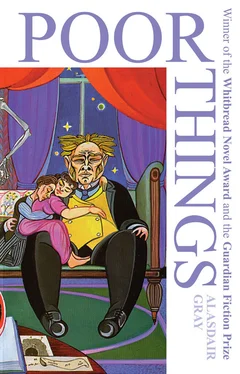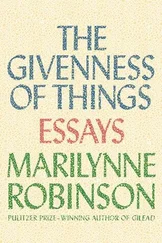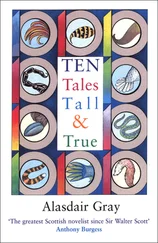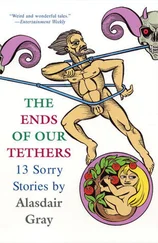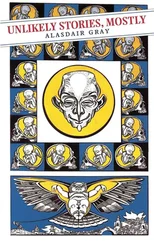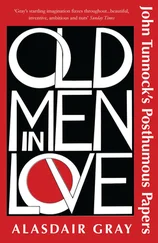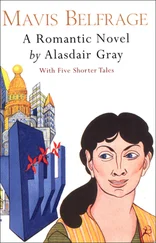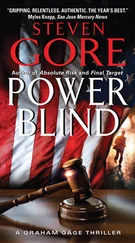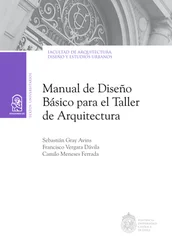Alasdair Gray
Poor Things
FOR MY WIFE MORAG
TO SHE WHO MAKES MY LIFE WORTH LIVING
Dr Archibald McCandless (1862–1911) was born in Whauphill, Galloway, the illegitimate son of a prosperous tenant farmer. He studied medicine at Glasgow University, worked briefly as a house surgeon and public health officer, then devoted himself to literature and the education of his sons. His once famous epic, The Testament of Sawney Bean , has long been unfairly neglected, and his wife suppressed the first edition of his greatest work, the autobiographical Poor Things . Recently rediscovered by the Glasgow local historian, Mike Donnelly, this weird narrative is as gripping as Hogg’s Confessions of a Justified Sinner , and in 1992 received both the Whitbread Award and the Guardian Prize.
Alasdair Gray, the editor, was born in Riddrie, Glasgow, 1934, the son of a cardboard-box manufacturer and part-time hill guide. He obtained a Scottish Education Department Diploma in Design and Mural Painting and is now a fat, balding, asthmatic, married pedestrian who lives by writing and designing things.
The doctor who wrote this account of his early experiences died in 1911, and readers who know nothing about the daringly experimental history of Scottish medicine will perhaps mistake it for a grotesque fiction. Those who examine the proofs given at the end of this introduction will not doubt that in the final week of February 1881, at 18 Park Circus, Glasgow, a surgical genius used human remains to create a twenty-five-year-old woman. The local historian Michael Donnelly disagrees with me. It was he who salvaged the text which is the biggest part of the book, so I must say how he found it.
Life in Glasgow was very exciting during the nineteen seventies. The old industries which had made the place were being closed and moved south, while the elected governors (for reasons any political economist can explain) were buying multistorey housing blocks and a continually expanding motorway system. In the local history museum on Glasgow Green the curator Elspeth King, her helper Michael Donnelly, worked overtime to acquire and preserve evidence of local culture that was being hustled into the past. Since the First World War the City Council had given the local history museum (called the People’s Palace) no funds to buy anything new, so Elspeth and Michael’s acquisitions were almost all salvaged from buildings scheduled for demolition. A store was rented in Templeton’s carpet factory (which was soon closing down) and to this place Michael Donnelly brought troves of stained-glass windows, ceramic tiles, theatre posters, banners of disbanded trade unions and all sorts of historical documents. Elspeth King sometimes gave Michael manual help with this work, as the rest of her staff were attendants sent by the head of the city art gallery in Kelvingrove and not paid to retrieve objects from dirty, unsafe buildings. Neither, of course, were Elspeth and Michael, so the new and very successful exhibitions they put on cost the City Council little or nothing.
While passing through the city centre one morning Michael Donnelly saw a heap of old-fashioned box files on the edge of a pavement, obviously placed there for the Cleansing Department to collect and destroy. Looking into them he found letters and documents dating from the early years of the century, the refuse of a defunct law office. A modern firm had inherited what remained of the old business, and thrown out what it did not need. The papers mainly concerned property dealings between people and families who had helped to shape the city in its earlier days, and Michael saw the name of the first woman doctor to graduate from Glasgow University, a name only known to historians of the suffragette movement nowadays, though she had once written a Fabian pamphlet on public health. Michael decided to take the files away by taxi and sift through them at leisure; but first he called on the firm which had put the boxes out and asked permission. It was denied. A senior partner (a well-known lawyer and local politician who will not be named here) told Michael that his look through the files had been a criminal act since they were not his property and intended for the municipal incinerator. He said every lawyer was sworn to keep a client’s business private, whether the lawyer inherited the business or not and whether the client lived or died. He said that the only sure way to keep old business private was to destroy proof that it had happened, and if Michael Donnelly saved any part of the heap from destruction he would be charged with robbery. So Michael left the heap as it was — except for a small item he had casually pocketed before learning this was a crime.
It was a sealed packet inscribed with these words in faded brown ink: Estate of Victoria McCandless M.D. / For the attention of her eldest grandchild or surviving descendant after August 1974 / Not to be opened earlier . A recent hand using a modern ball-point pen had scribbled a zig-zag line through this and this underneath: No surviving descendants . The seal of the packet had been broken at one end and the paper torn open, but whoever did so had found the book and letter inside so uninteresting that they had thrust them carelessly back — both protruded and the letter was crumpled, not folded. The arch-thief Donnelly examined this closely in the People’s Palace store during a tea-break.
The book was 7¼ by 4½ inches and bound in black cloth with a grotesque ornament stamped on the batters. On the fly-leaf someone had scribbled a sentimental verse. On the title-page this was printed: EPISODES FROM THE EARLY LIFE of a SCOTTISH PUBLIC HEALTH OFFICER / Archibald McCandless M.D. / Etchings by William Strang / GLASGOW: Published for the Author by ROBERT MACLEHOSE & COMPANY Printers to the University 1909 . This was not an encouraging title. Many shallow, gossipy books were published in those days with names like Leaves from an Inspector’s Log and The Opinions and Prejudices of Frank Clark, Barrister . When the author paid the publisher for them (as here) such books were usually duller than those for which the publisher paid the author. Turning to the first chapter Michael saw a typical heading of the period:
CHAPTER THE FIRST
My mother — my father — Glasgow University and early struggles — portrait of a professor — a financial proposal, rejected — my first microscope — an equal intelligence .
What most interested Michael Donnelly were the Strang illustrations, all portraits. William Strang (1859–1921) was a Scottish artist born in Dumbarton, who studied under Legros at the Slade School of Art, London. He is known nowadays for his engravings rather than paintings, and some of his best work went into book illustration. A doctor who could pay Strang to etch pictures for a privately printed book must have had a larger income than most public health officers, yet the Archibald McCandless whose face was on the frontispiece had not the look of a rich man or a doctor. The accompanying letter was even more perplexing. It was from Victoria McCandless M.D., widow of the author, telling the descendant who never existed that the book was full of lies. Here is part of it:
By 1974. . surviving members of the McCandless dynasty will have two grandfathers or four great-grandfathers, and will easily laugh at the aberration of one. I cannot laugh at this book. I shudder at it and thank the Life Force that my late husband had just this single copy printed and bound. I have burned. . the original manuscript and would have burned this too, as he suggests. . but alas! it is almost the only evidence left that the poor fool existed. He also paid a small fortune for it. . I do not care what posterity thinks of it, as long as nobody now living connects it with me.
Читать дальше
